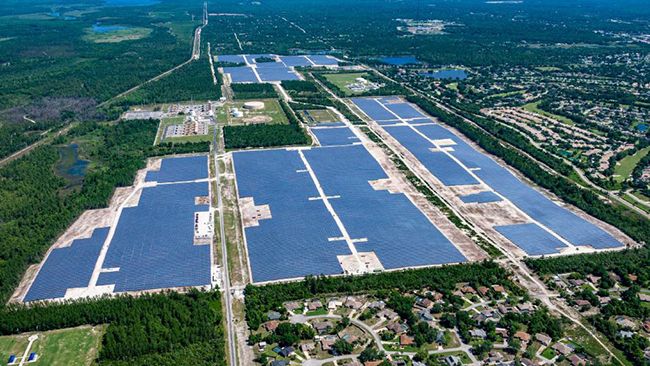– 2 other new solar sites begin serving customers
– Collectively, company’s Florida solar plants will eliminate nearly 3 billion pounds of carbon dioxide emissions annually
PVTIME – Duke Energy Florida (DEF) today filed the locations of its three newest solar power plants, which will provide cleaner, smarter energy solutions to benefit Florida customers.

- The Duette Solar Power Plant will be built on approximately 520 acres in Manatee County, Fla. Once operational, the 74.5-megawatt (MW) facility will consist of approximately 227,000 single-axis tracking solar panels, capable of producing enough electricity to power approximately 23,000 homes at peak production annually. Once completed, the estimated cost will be 42 cents per 1,000 kilowatt-hours (kWh) for a typical residential customer.
- The Charlie Creek Solar Power Plant will be built on 610 acres in Hardee County, Fla. The 74.9-MW facility will consist of approximately 235,000 single-axis tracking solar panels, capable of producing enough electricity to power approximately 23,000 homes at peak production annually. Once completed, the estimated cost will be 39 cents per 1,000 kWh for a typical residential customer.
- The Archer Solar Power Plant will be built on 630 acres in Alachua County, Fla. This 74.9-megawatt (MW) facility will consist of approximately 220,000 single-axis tracking solar panels, capable of producing enough electricity to power approximately 23,000 homes at peak production annually. Once completed, the estimated cost will be 32 cents per 1,000 kWh for a typical residential customer.
During construction, each solar project creates approximately 200 to 300 temporary jobs. All three solar power plants will be owned, operated and maintained by Duke Energy Florida and are expected to be finished in late 2021.
“The Archer, Duette and Charlie Creek solar power plants will complete Duke Energy Florida’s commitment to customers to provide 700 MW of clean, green energy by 2022,” said Catherine Stempien, Duke Energy Florida state president. “Once operational, our solar power plants will eliminate nearly 3 billion pounds of carbon dioxide emissions each year. The sun shines bright here in Florida, and we are committed to making more solar investments in the years to come.”
Duke Energy Florida currently has more than 500 MW of solar generation under construction or in operation, excluding the sites announced today. The company is investing an estimated $1 billion to construct or acquire a total of 700 MW of solar power facilities from 2018 through 2022 in Florida and is planning to reach a total of almost 1,700 MW of solar generation over the next 10 years.
Duke Energy Florida recently completed two other facilities:
- The Columbia Solar Power Plant in Columbia County, Fla., began serving customers on March 17, 2020. The facility is 74.9 MW with 245,000 solar panels.
Video of installation of one-millionth solar panel at Columbia Solar Power Plant.
Drone video of Columbia plant.
- The DeBary Solar Power Plant in Volusia County, Fla., began serving customers on May 14, 2020. The facility is 74.5 MW with 300,000 panels.
Solar projects under construction
The Twin Rivers Solar Power Plant is being built on 515 acres in Hamilton County, Fla. Once operational, the 74.9-MW facility will consist of approximately 235,000 tracking solar panels that track the movement of the sun and are capable of producing enough electricity to power approximately 23,000 homes at peak production. Once completed, the estimated cost will be 40 cents per 1,000 kWh for a typical residential customer.
The Santa Fe Solar Power Plant is being built on 607 acres in Columbia County, Fla. The 74.9-MW plant will consist of approximately 235,000 tracking solar panels, which will produce enough carbon-free energy to power more than 23,000 average homes at peak production. Once completed, the estimated cost will be 43 cents per 1,000 kWh for a typical residential customer.
Duke Energy Florida is encouraging renewable investments within the state. By buying existing solar projects and using a competitive process to select DEF solar contractors, solar panels and project material suppliers, the company’s solar power plants bring the greatest amount of dependable renewable energy online for customers in the most efficient and economical way while creating more jobs in the solar and energy-related markets.
Over the next decade, the company will continue to make innovative and targeted investments in additional solar power plants, battery storage technology, shared solar, transportation electrification and a modernized power grid to help meet customers’ needs for diverse, reliable energy solutions.
Duke Energy Florida
Duke Energy Florida, a subsidiary of Duke Energy, owns a diverse generation mix of natural gas, coal and renewables, providing about 10,200 megawatts of owned electric capacity to approximately 1.8 million customers in a 13,000-square-mile service area.
Duke Energy (NYSE: DUK), a Fortune 150 company headquartered in Charlotte, N.C., is one of the largest energy holding companies in the U.S. It employs 30,000 people and has an electric generating capacity of 51,000 megawatts through its regulated utilities, and 3,000 megawatts through its nonregulated Duke Energy Renewables unit.
Duke Energy is transforming its customers’ experience, modernizing the energy grid, generating cleaner energy and expanding natural gas infrastructure to create a smarter energy future for the people and communities it serves. The Electric Utilities and Infrastructure unit’s regulated utilities serve approximately 7.7 million retail electric customers in six states – North Carolina, South Carolina, Florida, Indiana, Ohio and Kentucky. The Gas Utilities and Infrastructure unit distributes natural gas to more than 1.6 million customers in five states – North Carolina, South Carolina, Tennessee, Ohio and Kentucky. The Duke Energy Renewables unit operates wind and solar generation facilities across the U.S., as well as energy storage and microgrid projects.










